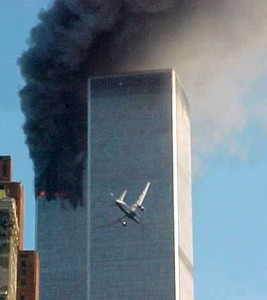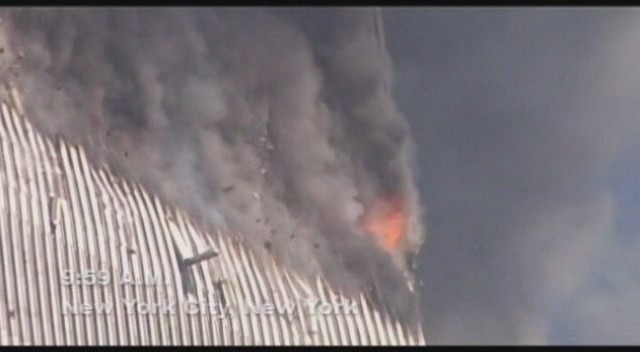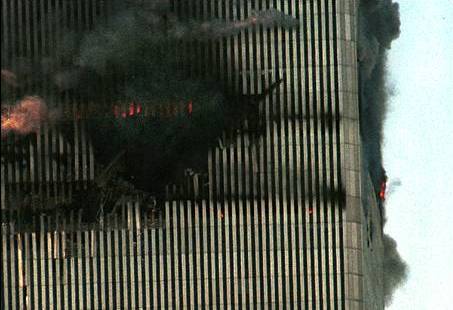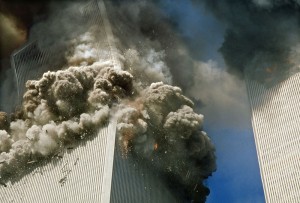Jun 23 2014
9/11 Conspiracy Debate – Part II
 This is the second of a four part written debate between myself and Michael Fullerton, who believes that the collapse of the Twin Towers on 9/11 was not due to the official story of damage from the impact of commercial jets, but rather the result of a controlled demolition. His initial post is here. This is my first response. Another round will follow in the next two weeks.
This is the second of a four part written debate between myself and Michael Fullerton, who believes that the collapse of the Twin Towers on 9/11 was not due to the official story of damage from the impact of commercial jets, but rather the result of a controlled demolition. His initial post is here. This is my first response. Another round will follow in the next two weeks.
_________
Part II – The Collapse of the Twin Towers was the Result of the Commercial Jet Impacts
by Steven Novella
When Michael first contacted me he challenged me (as he apparently has other skeptics before me) to a live debate on the topic of the collapse of WTC1 and WTC2 on Septermber 11, 2001. I offered instead this written debate, as I feel the written format is better suited to a technical debate, where references and facts can be checked.
Let me begin my first response by reviewing what appears to be the common ground between our two positions. Michael and I both agree that commercial airliners struck each of the Twin Towers on 9/11, resulting in explosions, burning jet fuel, and structural damage to the towers. We also agree that some time following these impacts, each tower collapsed.
We disagree on the best scientific explanation for these collapses. Michael supports the controlled demolition hypothesis. I accept the consensus of expert opinion that the collapse of the towers was due to the structural damage and weakening of the steel supports caused by the impact of the jets, the burning of the jet fuel, and the subsequent fires that burned through the buildings.
Michael characterized this position as the “official US Government explanation,” meant to emphasize the government’s role in investigating the collapse and downplay the independent scientific investigations and reviews. The National Institute for Standards and Technology gives this summary:
Based on its comprehensive investigation, NIST concluded that the WTC towers collapsed because: (1) the impact of the planes severed and damaged support columns, dislodged fireproofing insulation coating the steel floor trusses and steel columns, and widely dispersed jet fuel over multiple floors; and (2) the subsequent unusually large number of jet-fuel ignited multi-floor fires (which reached temperatures as high as 1,000 degrees Celsius, or 1,800 degrees Fahrenheit) significantly weakened the floors and columns with dislodged fireproofing to the point where floors sagged and pulled inward on the perimeter columns. This led to the inward bowing of the perimeter columns and failure of the south face of WTC 1 and the east face of WTC 2, initiating the collapse of each of the towers. Both photographic and video evidence—as well as accounts from the New York City Police Department aviation unit during a half-hour period prior to collapse—support this sequence for each tower.
The American Society for Civil Engineers agrees.
While I appreciate Michael’s primer on logic and “the scientific method,” I think he is misrepresenting both the process of science and its specific findings in this case.
He states:
“The official story of how the towers fell on 9/11 does not have a single solitary piece of supporting scientific evidence.”
He addresses the NIST report by stating: “The NIST report on the Twin Tower collapses provides sketchy evidence only for the collapse initiations and not the falls of the twin towers themselves.”
This is a bit of misdirection, or at least sloppy arguing. The “official story” includes the initiation of the collapse. Michael cannot dismiss evidence for the initiation of the collapse because it does not address how the towers fell after the collapse began. In fact the controlled demolition hypothesis is also about collapse initiation, so let us focus on that point.
 There is, in fact, plenty of scientific evidence to support the NIST conclusion. As we can see in these images, there is photographic evidence that the damaged floors were progressively sagging prior to collapse. There is also evidence that these sagging floors were pulling in the outer walls of the towers. These in turn are evidence that the ongoing fires were sufficiently hot to compromise the structural integrity of the steel supports, which include the core columns.
There is, in fact, plenty of scientific evidence to support the NIST conclusion. As we can see in these images, there is photographic evidence that the damaged floors were progressively sagging prior to collapse. There is also evidence that these sagging floors were pulling in the outer walls of the towers. These in turn are evidence that the ongoing fires were sufficiently hot to compromise the structural integrity of the steel supports, which include the core columns.
Given all this evidence, it would be difficult to make a case for how the towers could have avoided collapse.
Michael presents no real evidence to support the controlled demolition hypothesis. Some evidence is conspicuous in its absence. Despite the copious video recordings of the beginning of the collapse of each tower, no video shows, and no audio records, the explosions that would be required in a controlled demolition.
Michael’s core argument seems to be this:
“Every time in the history of modern human civilization when a skyscraper has come down in a similarly rapid and symmetrical manner as the Twin Towers, it has been a controlled demolition. The rapid fall times and highly symmetric descents of the Twin Towers then are currently only scientifically explainable by the use of some form of controlled demolition.”
The second sentence does not follow from the first. He assumes that a scientific explanation requires a prior event. Let’s say for arguments sake that there has been one and only one mass extinction on Earth due to an asteroid impact. It would still be possible to test the impact hypothesis and demonstrate it is the best explanation to a high degree of reliability, even without any prior impact-caused mass extinctions as a model.
Further, Michael’s argument seems to reduce to – the Twin Tower collapses were likely caused by a controlled demolition because they look like a controlled demolition, but he only gives two criteria for looking like a controlled demolition: rapid fall and symmetrical fall. Neither of these criteria are operationally defined – how symmetrical or how rapid? Without some technical evidence-based criteria, these are just subjective impressions.
 Let’s take, for example, the notion of a symmetrical fall. As you can see in the image of the South Tower, the initiation of the collapse of this tower was not what can reasonably be called symmetrical. The tower collapsed on one side and the upper tower fell significantly to that side. This, of course, initiated a full collapse – once one part of the structure gave way, the load that was being distributed to the rest of the structure greatly exceeded tolerance levels and collapse was inevitable.
Let’s take, for example, the notion of a symmetrical fall. As you can see in the image of the South Tower, the initiation of the collapse of this tower was not what can reasonably be called symmetrical. The tower collapsed on one side and the upper tower fell significantly to that side. This, of course, initiated a full collapse – once one part of the structure gave way, the load that was being distributed to the rest of the structure greatly exceeded tolerance levels and collapse was inevitable.
Michael tries to wiggle out of this point by writing: “Further, no controlled demolition is perfectly symmetrical either. However, all successful controlled demolitions are generally very symmetrical.” But “not perfectly symmetrical” doesn’t cover it. This tower is falling to one side. I certainly wouldn’t call it “very symmetrical.” If Michael is to allow this degree of falling to one side to count as “symmetricalish,” then that criterion loses all meaning.
Once the full collapse of the tower was under way, of course it is going to fall straight down. A structure of that size and nature would not have the strength to fall to the side (beyond what we see with the initial collapse). Once the structure failed there was nothing keeping the upper part of that building up. It would have to fall straight down, forcing the collapse of anything below it.
Michael agrees that the tower did not fall at free fall, which is easily verifiable in the many videos. Michael simply implies that it fell “too fast” for a collapse due to structural failure – but how fast is too fast? What is that based on? I have never seen anything to suggest that such a judgement is based on anything but naive guessing. No hard numbers.
There is, however, a detailed analysis showing that the towers would fall at near free fall. The weight of the falling upper part of the tower would so greatly exceed the load capacity of the lower floors that the collapse would hardly be slowed at all. Bazant and Zhou write:
Its integration shows that the time that the upper part takes to fall through the height of one story is, for cold columns, only about 6% longer than the duration of a free fall from that height, which is 0.87 s. For hot columns, the difference is of course much less than 6%. So there is hardly any ‘‘cushioning.’’ It is essentially a free fall.
Ironically, many proponents of the controlled demolition hypothesis use video evidence of controlled demolitions to bolster their case, even though they weaken it. Michael provided links to videos showing top-down controlled demolition. In these (and other) videos we see that taking out the supports of a single floor toward the top of the building can indeed cause the progressive collapse of the entire building below it.
Isn’t that exactly what happened with the towers? It doesn’t matter at all if the supports were exploded or if they were simply weakened by fire past the point that they could bear the weight of the floors above them. Once the tower started to collapse, no matter what caused it, it would pretty much look the same.
Really what we are looking for is evidence for how the collapse initiated. We have evidence of floor sagging, pulling in the outer supports, leading up to each tower collapsing on one side, then collapsing straight down. All these details support the NIST reconstruction, not controlled demolition.
Further we lack specific details that would indicate a controlled demolition, such as explosions.
Michael specifically claims there is no computer modeling of the collapse, but this is demonstrably wrong. I easily found computer modeling analysis, such as this one, which concluded:
This study showed that the combined effects of the aircraft impact damage to the structure and fire-proofing insulation, and the subsequent intense fires, caused the tower collapses.
Conclusion:
Michael provides no actual evidence that the collapse of either tower on 9/11 was initiated or at all affected by a controlled demolition.
He claims there is no evidence to support the standard theory. He apparently does not count the facts that jets did indeed plow into each tower, causing structural damage, with exploding jet fuel, leading to fires that burned for 56 minutes in the South Tower and 1 hour 42 minutes in the North Tower. The fires would plausibly weaken structural steel, reducing its ability to bear load. This results in the floors on the burning levels sagging, buckling the outer walls.
This sagging and buckling progressed until each tower looked as if it were about to collapse. Right at that moment, Michael would have you believe, each Tower was brought down by controlled demolition. The explosions were apparently invisible, silent, and coordinated so that the collapse would appear to begin at the exact level of each tower where the jet and fire damage was maximal. The explosives must also have survived without exploding prematurely, despite the raging fires.
Michael’s core logical error in making his case is depending on the claim that the towers fell in a manner that looks like controlled demolition, in that they fell fast and mostly straight down. These are not, however, features specific to controlled demolition. They would be true regardless of what initiated the collapse of such structures. In other words, Michael is relying on non-specific features with lots of wiggle room, and ignoring the absence of specific features – floor sagging and wall pulling favoring structural failure, and the absence of explosions arguing against controlled demolition. This is like diagnosing a rare infection by the presence of fever alone, and dismissing the absence of the characteristic rash that normally defines the infection.
Michael himself ironically provides evidence that initiating a collapse near the top of a building can still cause it to collapse all the way straight down to the ground. Here is another example.
To summarize, Michael claims:
There is no evidence to support the NIST model of collapse initiation. This is false. There is evidence of damage from the initial impact, fire damage, floor sagging, pulling in the outer walls, and the tilting of the upper section consistent with the columns failing on one side. This is all compelling evidence of structural failure sufficient to make total collapse inevitable.
There is no computer modeling of the collapse. This is false – computer modeling supports the conclusion of structural failure.
Prior history of controlled demolition is evidence that the towers were brought down by controlled demolition. This is false. The collapse of WTC 1 and 2 resemble controlled demolition in only the most superficial way, and not in any details specific to controlled demolition. The initiation of collapse was not symmetrical, but each tower tilted in a manner consistent with the failure of one side. Further the speed of the collapse is perfectly consistent with what would occur following failure of one floor in the upper part of each tower, regardless of the cause of that failure.
“There has never ever been a case where a skyscraper has come down in a similar manner as the Twin Towers without using some form of controlled demolition.” This is irrelevant, since commercial jets loaded with fuel were never flown deliberately into buildings similar to the Twin Towers before. Further, Michael does not operationally define “similar manner,” rendering his point worthless. The extent they are “similar” is superficial, as discussed above.
Michael is trying to argue that the NIST model is an extraordinary claim because it has never happened before, but that is not reasonable. Rather, multiple independent analyses by experts indicate that the collapse was not extraordinary, but inevitable. It would be extraordinary, given the condition of the towers and the evidence presented, if the towers did not collapse due to structural failure.
Therefore, the evidence overwhelmingly supports the NIST theory of collapse, while there is no evidence in favor of controlled demolition.






